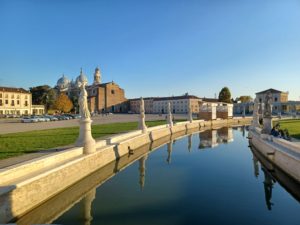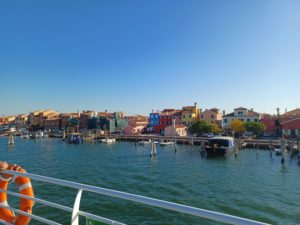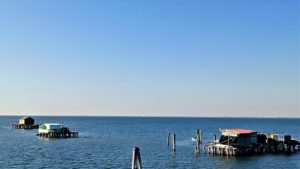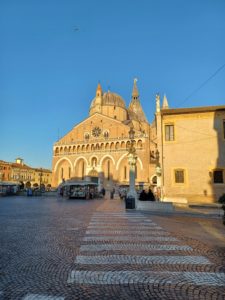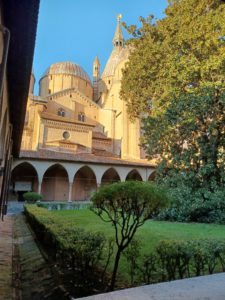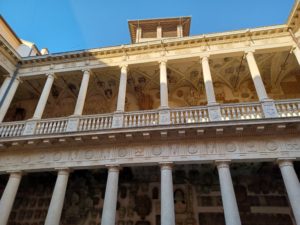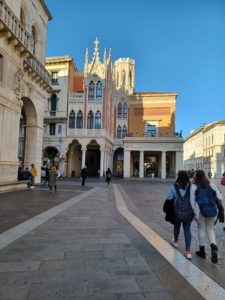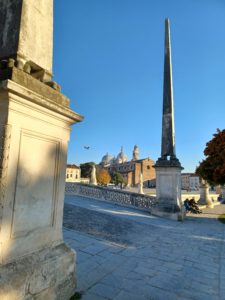On our recent CroisiEurope `Gems of Venice` river cruise on MS Michelangelo there was a choice of optional excursions but the only one we booked was the trip to Padua (Padova) as we’d never been there and wanted to see this historic city, famous for its art, architecture, St Anthony’s basilica and university. This optional excursion costs £53 per person in 2022 if booked in advance.
We all had breakfast earlier than usual that day so that Michelangelo could leave its mooring in Venice for the cruise through the southern lagoon. The weather was warm and sunny; we passed islands that had previously been used for infirmaries or isolation but are now lavish resorts, then Lido, the MOSE flood barriers, Sacca degli Scardoran (wooden fishing huts on stilts that house machinery and boats used to catch shell fish) and the attractive fishing town of Pellestrina. The ship’s purser gave a commentary in French during the cruise and also translated it into English for our benefit. I’d read about this area in Jan Morris’s book on Venice and it was wonderful to see it, albeit from a larger vessel than she sailed in. As soon as we arrived in Chioggia we had our lunch on board and then those visiting Padua were allocated a place on one of the three coaches for the final part of the journey; anyone not going to Padua went back on the ship to Venice. The coach ride to Padua was underwhelming – featureless flat areas with a few poplar trees then a motorway through an extensive area of large retail parks and warehouses – not dissimilar to Thurrock in Essex.
On arrival in Padua each coachload set off with their tour guides to see the centre of the city but the two of us had an English speaking guide all to ourselves. Our guide spoke very good English and we embarked on a speedy walking tour of the main places of interest. We’d been dropped off at Prato della Valle, the largest `square` in Italy, although it is actually oval, surrounded by a canal and encircled by 78 statues. Our guide told us the history behind the statues and then held up the traffic by raising her hand so we could cross the wide road to head towards the nearby Basilica of St Anthony, locally known as `il Santo`. Outside the basilica is a famous 15th century bronze statue by Donatello. Our guide was very knowledgeable about art and music so she was happy that one of us (not me) already knew about the artists and composers who had links to Padua. The Basilica is a Roman Catholic church dedicated to St Anthony, originally from Portugal (I remember that bit!) and is a place of pilgrimage, although it is not the city’s main cathedral. The basilica, started in the 13th century and completed by the 14th, was extended over the centuries so the exterior now has Romanesque, Byzantine and Gothic elements; its domes are like those on St Mark’s in Venice. Inside there are many significant paintings, frescoes and a lot of gilding. The devout queued patiently to touch the tomb of Saint Anthony. We left the basilica by a different door and entered cloisters that led to a shop and, thankfully, paid toilets. We then walked to some of the nearby university buildings and saw the old courtyard and corridor of Bo Palace. Padua University is the second oldest university in Italy and on the ceiling of the corridor are the shields and names of famous people who’ve studied there in the past – William Harvey, Sir Francis Walsingham, Nicholaus Copernicus, John Caius and Giacomo Casanova, to name some I’ve heard of – we then moved on to see the Palazzo della Ragione, a medieval town hall and market. The ground floor still has an indoor market and the great hall is on the 1st floor. We read the information board outside and our guide said we could return in our free time and pay to go inside to see the wonderful 14th century frescoes covering all four walls. The palazzo separates two market squares, the Pazza delle Erbe and Piazza dei Frutti, where there is a fresh produce market every day. Round another corner our guide pointed out the Pedrocchi cafe, which was founded in the 18th century as a coffee house but has undergone many alterations and additions over the years. It combines many different styles of architecture and interior decoration and the main rooms are now white, green and red, the colours of the Italian flag; the green room has always been a place where people can sit without having to order anything if they don’t want, or can’t afford to, the red (central) room has the historic bar and is rather expensive, while the white room is for dining. Our guide also told us that the speciality of the house is coffee with mint flavoured cream on top and a dusting of cocoa powder.
Our guide then left us to fit in anything else we wanted to do and then return to the coach pick-up point ourselves. A visit to Palazzo della Ragione was out of the question due to the lack of time so we headed back towards the square where we’d started as we could see on the map we’d been given that the Botanical Garden was nearby and we hoped to have enough time to have a quick look. Unfortunately our map didn’t show where the entrance was and we’d already passed it. The return coach ride to Venice took longer than it should have because of an accident on the motorway. The excursion was a good introduction to the city although if we ever return to Venice we’ll go back to Padua by train for a longer visit as the rail journey only takes about half an hour and can cost less than £10 return; we should then have time to see inside Palazzo della Regione, explore the Botanical Garden, have coffee at Pedrocchi Cafe and find Scrovegni Chapel with its famous frescoes by Giotto.
“For details of CroisiEurope Gems of Venice cruise and Padua excursion”:http://www.croisieurope.co.uk/cruise/short-break-venice-classic#way
